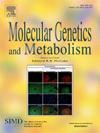Use of lysine reduction therapies in patients with pyridoxine dependent epilepsy due to Antiquitin deficiency – A cohort study
IF 3.5
2区 生物学
Q2 ENDOCRINOLOGY & METABOLISM
引用次数: 0
Abstract
Pyridoxine dependent epilepsy due to Antiquitin deficiency (PDE-ALDH7A1) is a disorder of lysine catabolism that results in accumulation of α- aminoadipic semialdehyde (α-AASA) and Δ1-piperideine 6-carboxylic acid (P6C). It is hypothesised that these metabolites are neurotoxic and that chronic exposure may have detrimental long-term effects, particularly on the young developing brain.
Lysine reduction therapies in the form of lysine restricted diet (LRD) and arginine, have been used as an adjunct to pyridoxine for the treatment of PDE-ALDH7A1 for the last 15 years with an aim to improve long-term developmental outcomes by reducing α-AASA and P6C. We present the management and outcomes for a cohort of 17 PDE-ALDH7A1 patients from our centre.
In this study we show that LRD leads to a reduction in plasma lysine levels and urine α-AASA concentrations and a correlation between these is seen in individual patients, supporting the treatment hypothesis.
LRD alone was shown to be sufficient to reduce plasma lysine into the target treatment range and addition of arginine was not required.
Transition to LRD and long-term adherence is easier to achieve in patients under 6 months of age, compared to older patients.
Lysine reduction therapies did not offer any additional benefit on seizure control over pyridoxine monotherapy but in keeping with previous studies, this study supports early initiation of LRD in patients under 6 months with cognitive function scores maintained in some, although longer term follow up is required and ongoing.
赖氨酸还原疗法在抗黄嘌呤缺乏所致吡哆醇依赖性癫痫患者中的应用——一项队列研究
抗黄素缺乏症引起的吡哆醇依赖性癫痫(PDE-ALDH7A1)是一种赖氨酸分解代谢紊乱,导致α-氨基二甲酸半醛(α- aasa)和Δ1-piperideine 6-羧酸(P6C)的积累。据推测,这些代谢物具有神经毒性,长期接触可能会产生有害的长期影响,特别是对年轻发育中的大脑。在过去的15年里,以赖氨酸限制饮食(LRD)和精氨酸形式的赖氨酸还原疗法被用作吡哆醇治疗PDE-ALDH7A1的辅助疗法,目的是通过降低α-AASA和P6C来改善长期发育结局。我们介绍了来自我们中心的17例PDE-ALDH7A1患者的管理和结果。在这项研究中,我们发现LRD导致血浆赖氨酸水平和尿α-AASA浓度的降低,并且在个体患者中看到两者之间的相关性,支持治疗假设。LRD本身已被证明足以将血浆赖氨酸降低到目标治疗范围,而不需要添加精氨酸。与老年患者相比,6个月以下的患者更容易过渡到LRD和长期依从性。与吡哆醇单药治疗相比,赖氨酸还原疗法在癫痫发作控制方面没有提供任何额外的益处,但与先前的研究一致,该研究支持6个月以下认知功能评分维持的患者早期开始LRD,尽管需要进行更长期的随访。
本文章由计算机程序翻译,如有差异,请以英文原文为准。
求助全文
约1分钟内获得全文
求助全文
来源期刊

Molecular genetics and metabolism
生物-生化与分子生物学
CiteScore
5.90
自引率
7.90%
发文量
621
审稿时长
34 days
期刊介绍:
Molecular Genetics and Metabolism contributes to the understanding of the metabolic and molecular basis of disease. This peer reviewed journal publishes articles describing investigations that use the tools of biochemical genetics and molecular genetics for studies of normal and disease states in humans and animal models.
 求助内容:
求助内容: 应助结果提醒方式:
应助结果提醒方式:


